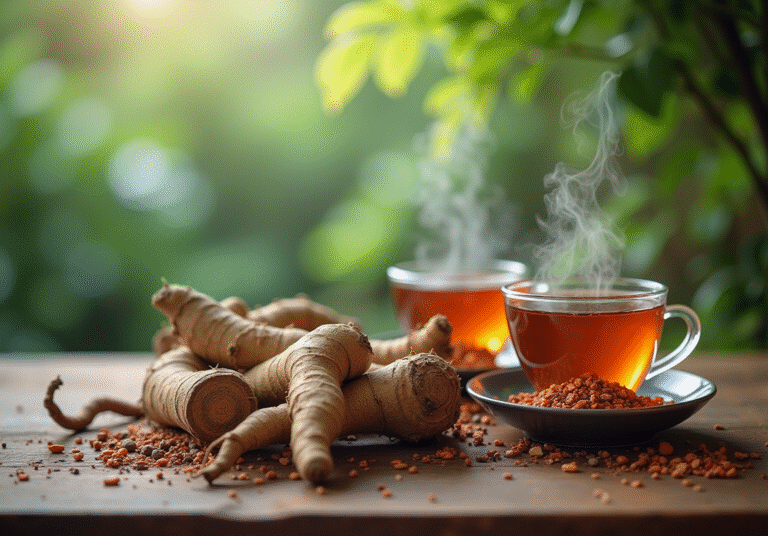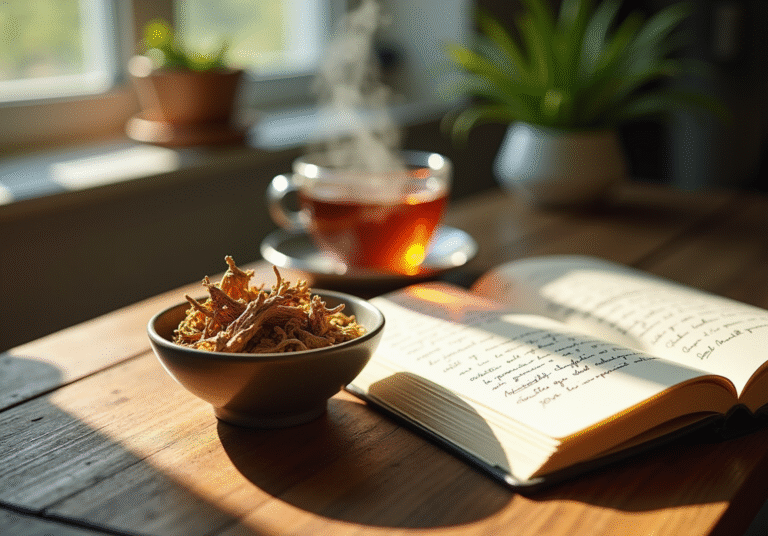Combine Rhodiola and Ashwagandha Together for Optimal Benefits
Overview
The combination of Rhodiola and Ashwagandha offers optimal benefits for stress management and overall vitality enhancement. How do these adaptogens work together? Rhodiola’s energizing properties complement Ashwagandha’s calming effects. This synergy leads to improved cognitive function, emotional well-being, and resilience to stress when taken together in recommended dosages. By understanding their individual benefits, you can make informed choices for your health.
Introduction
The quest for optimal health often leads individuals to explore the power of adaptogens. Among these, Rhodiola and Ashwagandha stand out as two of the most revered options. Both herbs boast an array of benefits, from enhancing physical performance to alleviating stress and anxiety. This makes them attractive choices for those seeking a natural boost.
However, the question remains: how can the combination of these two potent herbs maximize their individual benefits while minimizing potential risks? Understanding their unique properties and best practices for integration is essential for anyone looking to harness their full potential.
Understand Rhodiola and Ashwagandha: Key Properties and Benefits
Ashwagandha and Rhodiola, both powerful adaptogens, are recognized for their ability to help the body adapt to stress while enhancing overall health. Rhodiola, often referred to as ‘golden root,’ is celebrated for its capacity to improve physical performance, reduce fatigue, and enhance mental clarity. This herb contains active compounds such as rosavin and salidroside, which are believed to boost energy metabolism and cognitive function. Research indicates that effective doses of Rhodiola for alleviating symptoms of stress, fatigue, or depression typically range from 400 mg to 600 mg per day. Studies have shown significant improvements in mood and quality of life among participants using these doses.
On the other hand, Ashwagandha, commonly known as ‘Indian ginseng,’ is well-regarded for its calming effects and ability to reduce anxiety and stress. Its active components, particularly withanolides, have been shown to lower cortisol levels, promoting a sense of calm and balance. Ongoing research in 2025 continues to underscore the health benefits of this herb, including its potential role in managing stress-related conditions and enhancing cognitive function.
When combined, rhodiola and ashwagandha together provide a synergistic approach to stress management and vitality enhancement, making them a favored choice for individuals seeking to improve their health as they age. Case studies have demonstrated that the combination of these herbs can lead to enhanced cognitive abilities, including improved memory and focus, further supporting their use in holistic health strategies.
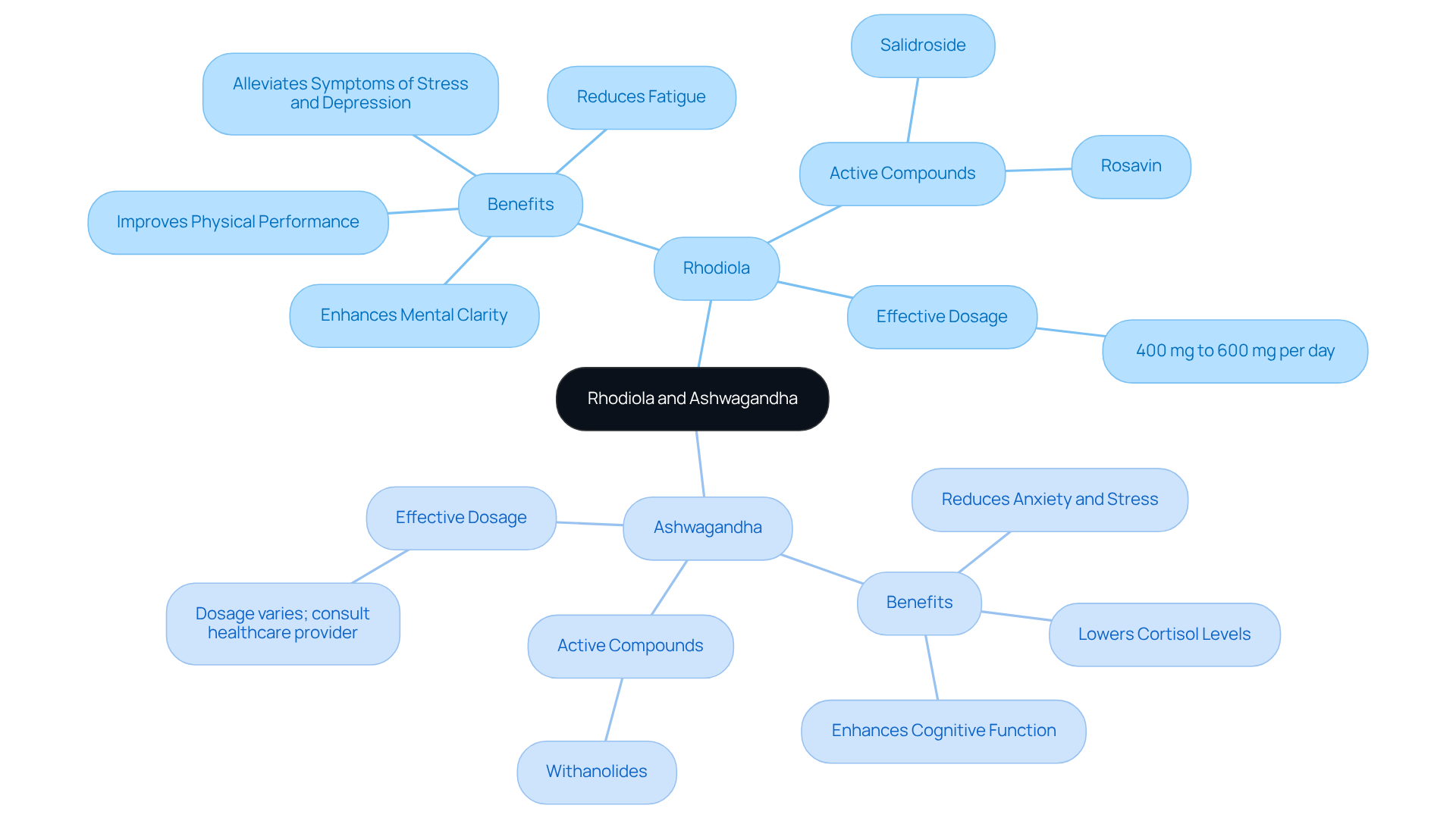
Assess Safety: Evaluating the Risks of Combining Rhodiola and Ashwagandha
Before mixing rhodiola and ashwagandha together, it is essential to assess the safety profiles of both herbal supplements. Both adaptogenic plants, when taken as rhodiola and ashwagandha together, are generally considered safe for most individuals at suggested dosages, typically ranging from 200 to 600 mg for rhodiola and 300 to 600 mg for ashwagandha daily. However, potential interactions with medications, particularly those that influence mood or blood pressure, warrant careful consideration when taking rhodiola and ashwagandha together. For instance, both herbs may lower blood pressure, which could pose risks for individuals on antihypertensive medications.
Initially using herbal supplements individually is recommended to evaluate the advantages and possible drawbacks encountered with each, as noted by Tod Cooperman, M.D. Individuals with specific health conditions, such as bipolar disorder or thyroid disorders, should consult a healthcare professional before initiating these supplements. Pregnant or breastfeeding women are also advised to exercise caution and seek medical guidance, as this herb has traditional associations with abortifacient properties.
Monitoring for adverse effects is essential when starting a new supplement regimen. Users have reported gastrointestinal discomfort and mood changes, highlighting the importance of being vigilant during the initial phases of supplementation. While both adaptogens are generally well tolerated, specific caution is advised for individuals with certain health conditions. By understanding these factors, individuals can make informed decisions about integrating these herbs into their wellness routines. Additionally, the herb is suggested to be consumed in the morning or early afternoon, while another herbal remedy is best taken in the evening or at night for optimal benefits.
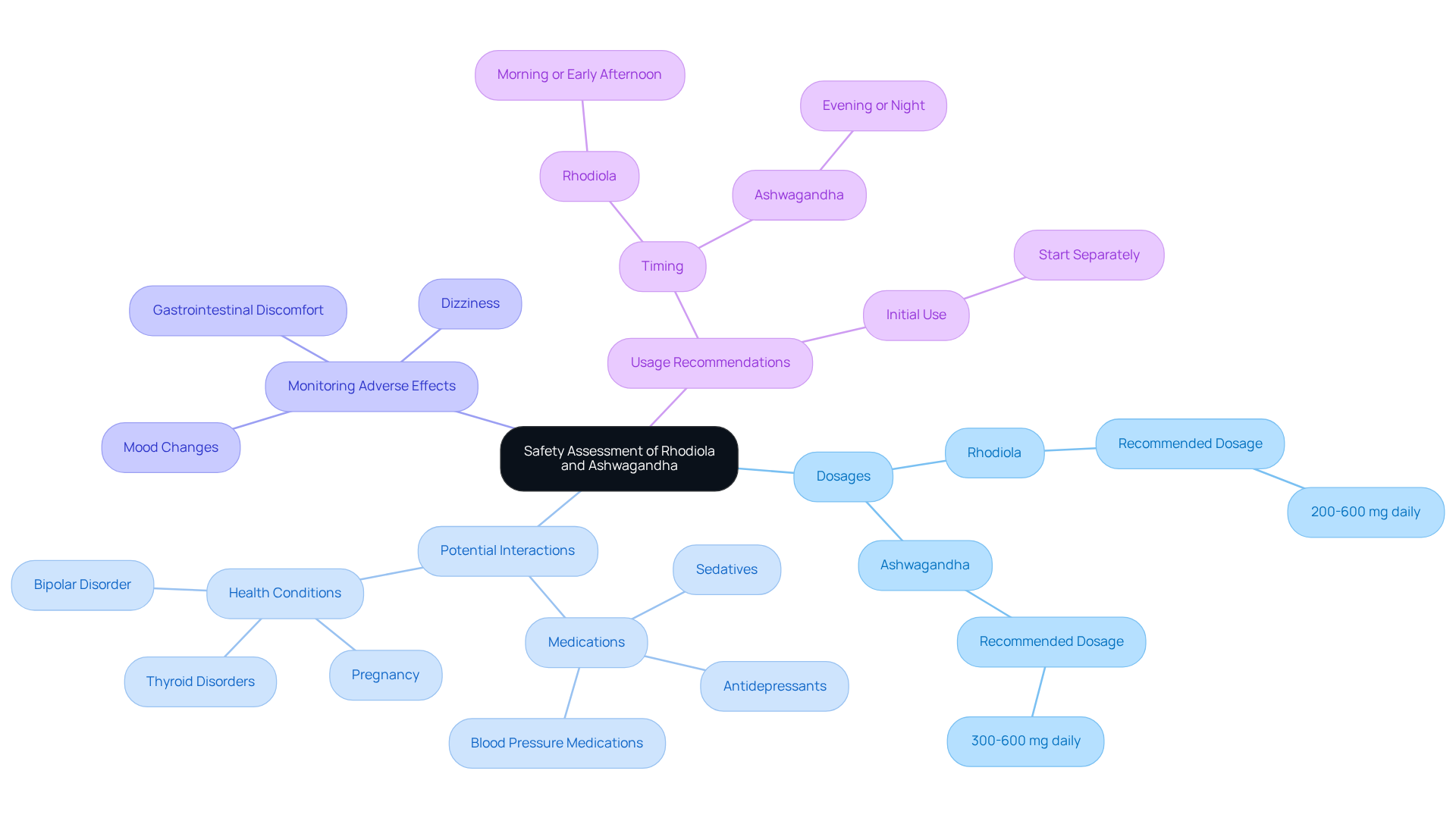
Implement Combination: Best Practices for Taking Rhodiola and Ashwagandha Together
To effectively combine Rhodiola and Ashwagandha, consider the following best practices:
-
Choose Quality Supplements: Opt for high-quality, standardized extracts from reputable brands to guarantee potency and purity. This ensures that you receive the full benefits of these adaptogenic herbs.
-
Dosage: Suggested amounts for Rhodiola typically range from 200-600 mg per day, while Ashwagandha is generally consumed at 300-600 mg daily. Starting with lower doses allows you to assess your tolerance and adjust as necessary.
-
Timing: For maximum benefits, take Rhodiola in the morning to utilize its energizing properties, while Ashwagandha is best consumed in the evening to encourage relaxation and enhance sleep quality.
-
Consistency: Incorporate both herbs into your daily routine consistently for the best results. They can be easily added to smoothies, teas, or taken as capsules.
-
Monitor Responses: Maintain a journal to record your mood, energy levels, and any side reactions. This practice will help you adjust dosages as needed and ensure that you are achieving the desired benefits.
-
Possible Adverse Reactions: Be mindful of possible adverse reactions, such as digestive problems, mood alterations, or sleepiness. If you encounter any negative reactions, consider modifying your dosage or seeking advice from a healthcare expert.
-
Synergistic Effects: Combining these herbs may provide enhanced benefits for stress management and overall well-being, as they work together to balance energy and relaxation.
-
Caution for Pregnant or Breastfeeding Individuals: It is advised to steer clear of these herbs if you are expecting or nursing due to inadequate research on their impact in these groups.
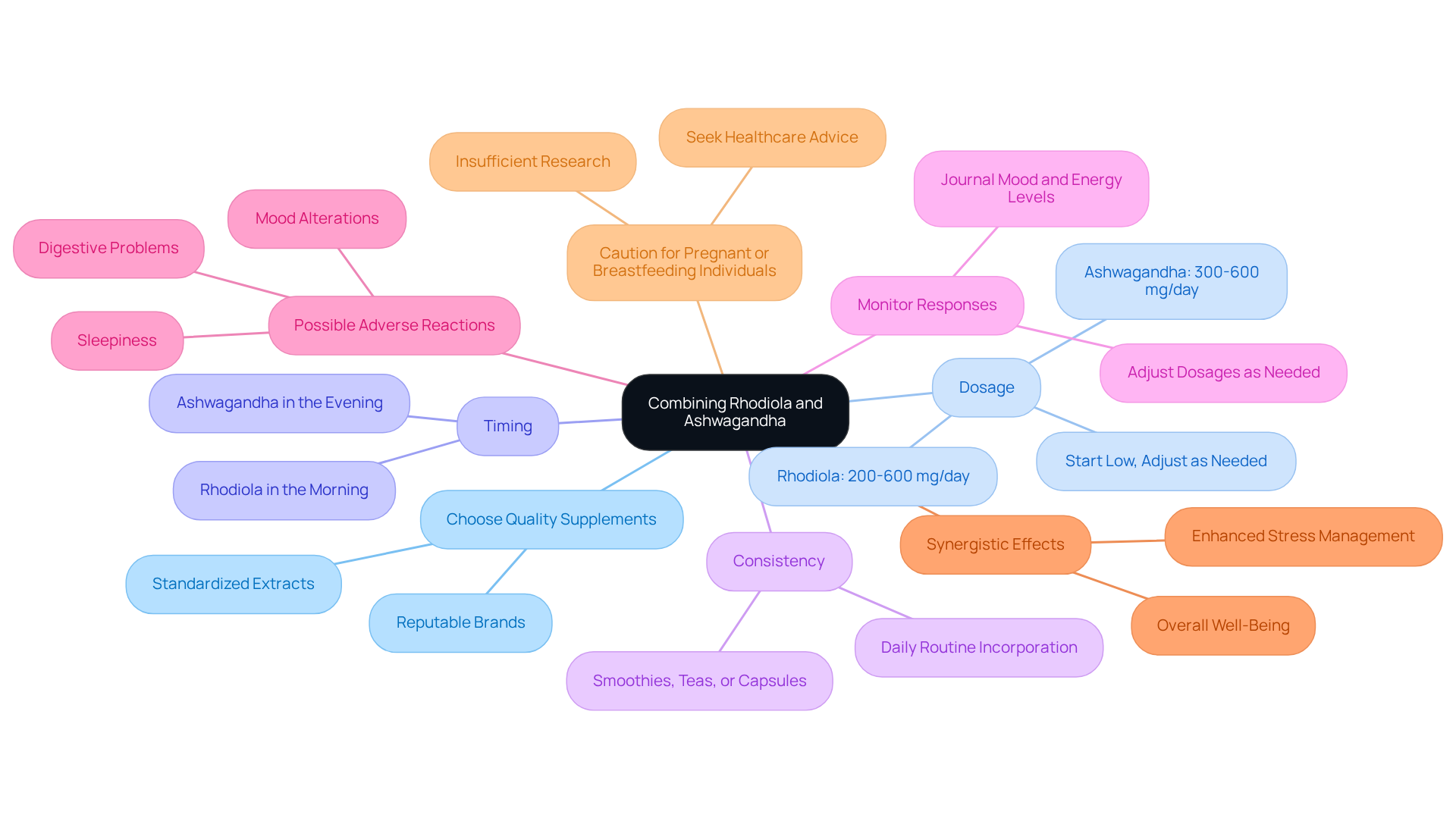
Explore Synergy: Benefits of Combining Rhodiola and Ashwagandha
The combination of rhodiola and ashwagandha together can yield significant advantages due to their supportive properties. The stimulating effects of one herb can counterbalance the calming effects of the other, resulting in a balanced approach to managing stress. This synergy may enhance cognitive function, improve physical performance, and promote emotional well-being. Furthermore, the combination may support hormonal balance, particularly for individuals experiencing stress-related hormonal fluctuations.
By incorporating both plants into a daily routine, individuals may notice enhanced resilience to stress, elevated energy levels, and an increased sense of overall vitality, making it a potent strategy for healthy aging. It is typically recommended to take Ashwagandha at a dosage of 300-500 mg per day and Rhodiola at 200-600 mg per day. Additionally, alternating the use of these plants for 6-8 weeks followed by a 2-4 week pause is advisable. Pregnant or breastfeeding individuals should avoid these herbs due to insufficient studies on their effects.
As noted by Cynthia Cobb, ‘When taken together, rhodiola and ashwagandha together may enhance stress management, energy, and well-being.
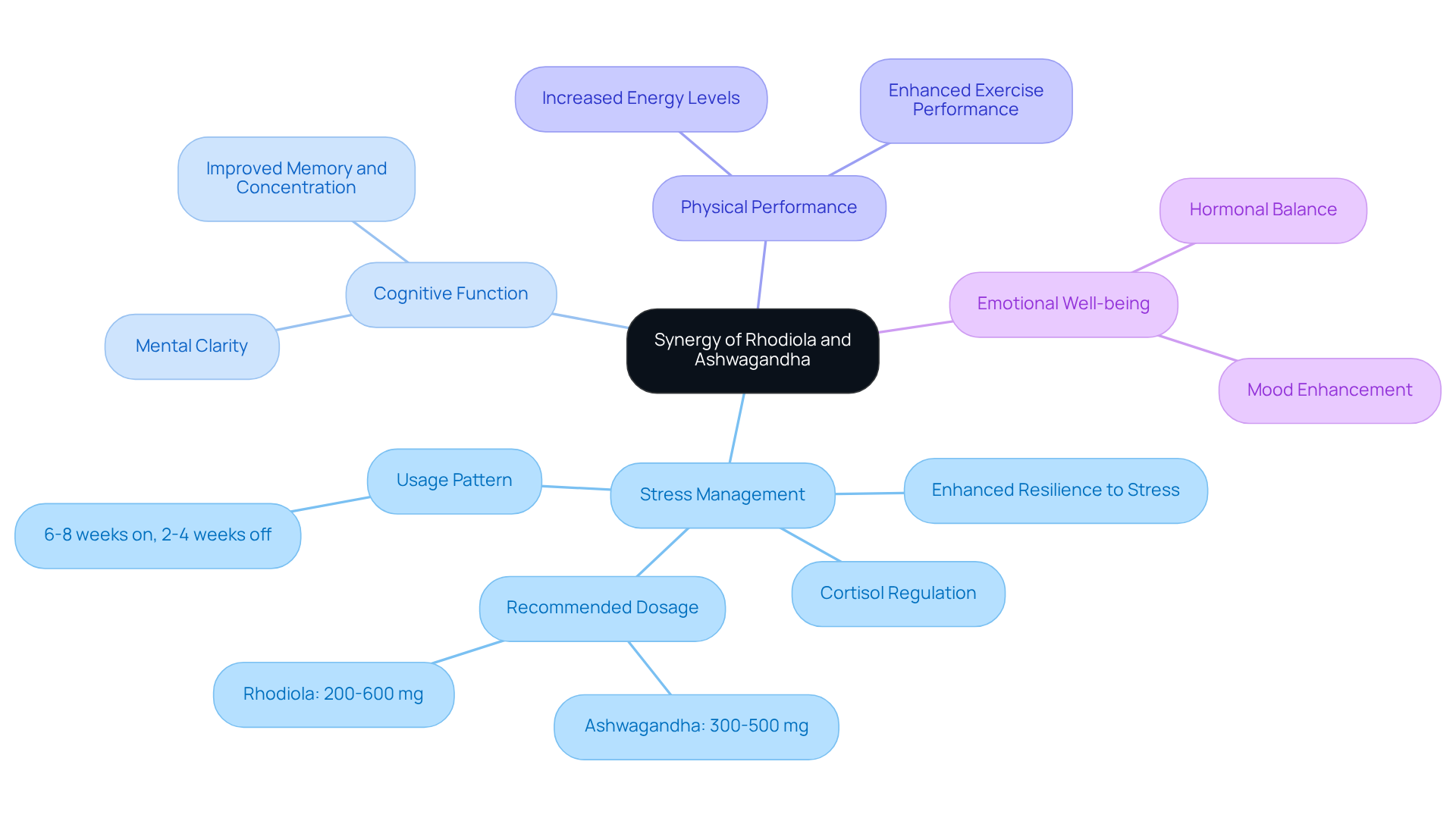
Conclusion
Combining Rhodiola and Ashwagandha presents a powerful opportunity to harness the benefits of two renowned adaptogens. This synergistic partnership not only aids in stress management but also enhances overall vitality, making it a compelling choice for those seeking to improve their health and well-being.
Key points highlight the individual strengths of both herbs—Rhodiola’s energizing properties and Ashwagandha’s calming effects. Together, they offer a balanced approach to:
- Stress relief
- Improved cognitive function
- Emotional stability
Safety considerations, such as appropriate dosages and potential interactions with medications, are crucial, ensuring that individuals can integrate these supplements into their routines responsibly.
Ultimately, the combination of Rhodiola and Ashwagandha stands out as a valuable strategy for enhancing resilience against stress and promoting a sense of overall wellness. Those interested in exploring this potent duo should consider adopting best practices for usage while remaining mindful of their individual health needs. By doing so, individuals can unlock the full potential of these adaptogens, paving the way for a healthier, more balanced life.
Frequently Asked Questions
What are Rhodiola and Ashwagandha?
Rhodiola and Ashwagandha are powerful adaptogens known for helping the body adapt to stress while enhancing overall health.
What are the key benefits of Rhodiola?
Rhodiola, also known as ‘golden root,’ improves physical performance, reduces fatigue, enhances mental clarity, and contains active compounds like rosavin and salidroside that boost energy metabolism and cognitive function.
What is the recommended dosage of Rhodiola for stress and fatigue relief?
Effective doses of Rhodiola for alleviating symptoms of stress, fatigue, or depression typically range from 400 mg to 600 mg per day.
How does Ashwagandha help with stress and anxiety?
Ashwagandha, commonly known as ‘Indian ginseng,’ has calming effects and reduces anxiety and stress by lowering cortisol levels, promoting a sense of calm and balance.
What ongoing research is being conducted on Ashwagandha?
Ongoing research in 2025 continues to explore the health benefits of Ashwagandha, particularly its role in managing stress-related conditions and enhancing cognitive function.
What are the benefits of combining Rhodiola and Ashwagandha?
When combined, Rhodiola and Ashwagandha provide a synergistic approach to stress management and vitality enhancement, leading to improved cognitive abilities, including memory and focus.
Who might benefit from using Rhodiola and Ashwagandha together?
Individuals seeking to improve their health as they age may benefit from the combination of these herbs for enhanced stress management and overall vitality.

